From internment in Trial Bay to exile in Berkeley: the German physicist Peter Pringsheim and his connection with Australia
James N. Bade A *
A *
A
Abstract
Peter Pringsheim, best known as professor of physics at the University of Berlin, has an unusual connection with Australia. His attendance at the 1914 conference of the British Association for the Advancement of Science, which was held in Melbourne, coincided with the outbreak of World War 1, and he was interned as an enemy alien at the Trial Bay Internment Camp in New South Wales from October 1914 until July 1919. However, with the support of key Australian and New Zealand scientists, Pringsheim used his time at Trial Bay to write a scientific paper on fluorescence and phosphorescence which established him as a world authority on this branch of atomic physics. On his return to Berlin, he was promoted to professor and it seemed that nothing could now stand in the way of his career. In a grim twist of fate, however, political developments in Germany in the 1930s then forced him into exile in Belgium and the United States.
Keywords: antisemitism, Australian internment, enemy aliens, exile, fluorescence and phosphorescence, international scientific cooperation, physics, World War 1.
The working life of a scholar or researcher is not typically dramatic. High points are likely to be moments of insight in the study or library or earnest discussions with colleagues in seminar rooms or laboratories. Yet for many German scientists in the twentieth century, orderly progress toward a sense of modest professional achievement was disrupted unexpectedly by political forces beyond their control. The physicist Peter Pringsheim is a particularly striking example because of the way in which he used his amiable personality and friendships in the English-speaking world to turn difficult situations to his advantage.
Pringsheim, who was best known as a professor of physics at the University of Berlin, has a distinctive association with Australia. His attendance at the 1914 conference of the British Association for the Advancement of Science that was held in Melbourne coincided with the outbreak of World War 1, and he was interned as an enemy alien at the Trial Bay Internment Camp in New South Wales from October 1914 until July 1919 (Fig. 1). Pringsheim’s sojourn in Australia was thus completely unexpected, but he was able to obtain the support of key Australian and New Zealand scientists to write a treatise on fluorescence and phosphorescence. On his return to Berlin, this treatise led to his promotion to a professorship in physics and established him as a world authority in this branch of atomic physics. In a tragic twist of fate, however, anti-semitism in Germany and World War 2 then forced him into exile in Belgium and the United States where once again he was able to turn an unexpected and difficult situation to his advantage (Fig. 2).
Peter Pringsheim as an internee in Australia. (SP 421/4 4730 Peter Pringsheim, National Archives of Australia, Sydney; many thanks to Eve Terry of National Archives of Australia, email of 15 December 2023, for clarifying copyright issues and thus enabling the reproduction of this and other National Archives of Australia items reproduced in this article).
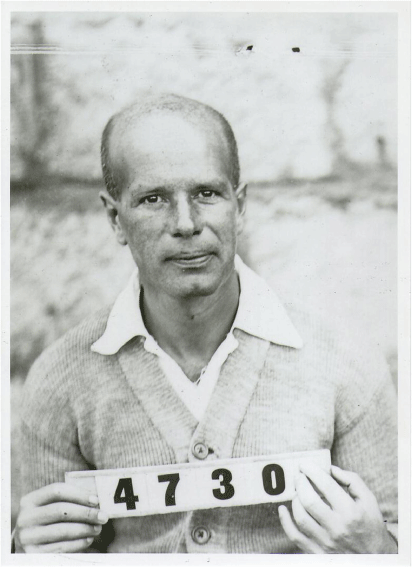
Trial Bay Internment Camp, New South Wales, Australia, ~1917. (Australian War Memorial, Canberra, negative no. H17635, permission for publication granted 24 November 2023).
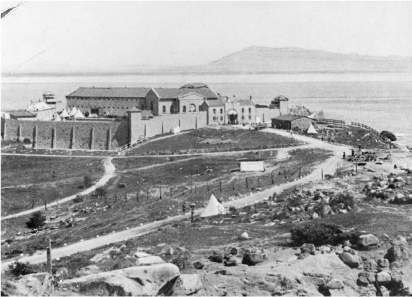
Peter Pringsheim, born in Munich in 1881, was the second son of Alfred Pringsheim, a professor of mathematics at the University of Munich, and Hedwig Dohm-Pringsheim, a well-known actress. He was thus born into a talented and prominent family who were of Jewish ancestry but members of the German Protestant Church. Erik, his older brother, studied law in Cambridge; Heinz, his younger brother, was an archaeologist; Klaus, his youngest brother, was a gifted musician, composer and conductor; Klaus’s twin sister, Katia, became an international celebrity as the wife of the German novelist Thomas Mann, whom she married in 1905; before this she had excelled in her studies of science and mathematics at the University of Munich.1
After attending primary and secondary schools (Volksschule and Wilhelms-Gymnasium) in Munich, Peter Pringsheim carried out his military service with the Royal Bavarian 1st Field Artillery Regiment in 1899, and was called back for further training in 1902 and 1906. He enrolled at the University of Munich in 1900, where he studied physics from 1900 to 1906. He was awarded a PhD on 16 July 1906 with a thesis on electrical discharges as a function of impressed voltage (Spitzenentladungen als Funktion der angelegten Spannung) supervised by Wilhelm Conrad Röntgen, who had been awarded the first Nobel Prize in Physics in 1901 for his discovery of X-Rays. After two years of post-doctoral studies at the universities of Göttingen (under Professor Eduard Riecke) and Cambridge (under Professor J. J. Thomson of the Cavendish Laboratory, who had been awarded the Nobel Prize in Physics in 1906), he was appointed to the Institute of Physics at the University of Berlin in 1908.
Partly because of his interest in the English-speaking world, enkindled by his time at the University of Cambridge, Pringsheim took part in the 1909 conference of the British Association for the Advancement of Science held at Winnipeg, Canada. In collaboration with his colleague Dr Robert Pohl he published a number of research articles on forms of electric lighting; he and Pohl gave papers on this topic at conferences in Austria and France in 1913 and 1914. Pringsheim then decided in 1914 to give a report on his research findings to the next conference of the British Association for the Advancement of Science, that was to be held in Melbourne, Australia. Unfortunately for Pringsheim, the Melbourne conference coincided with the outbreak of World War 1; because of his German ‘enemy alien’ status he was interned at Trial Bay, New South Wales, from October 1914 until July 1919, when he was repatriated to Germany.2
What were the circumstances that led to Pringsheim’s internment? At the outbreak of war, Pringsheim and the German anthropologist Fritz Gräbner, who had also attended the conference, were requested by the Australian authorities to sign a declaration that they would not take part in hostilities against Great Britain; they would then be free to leave. According to Gerhard Fischer and Valentin Wehefritz, Pringsheim and Gräbner refused to sign this declaration, and their internment was a direct consequence3 (Fig. 3). The files of the Australian military authorities tell a completely different story, however. Pringsheim and Gräbner did in fact sign the declaration and received permission to leave Australia (Fig. 4). A memorandum dated 16 October 1914 from Colonel Wallack, Commandant, 2nd Military District, Sydney, to the Secretary of the Department of Defence, confirms that Gräbner signed the declaration on 12 October; an undated signed declaration by Peter Pringsheim was also enclosed with the memorandum. The files show that Gräbner and Pringsheim were to leave for Germany on 24 October on the Ventura. However, before they left, a letter from Gräbner to his wife was intercepted and translated for the military authorities. Unfortunately for both Gräbner and Pringsheim, Gräbner’s letter contained some tactless remarks about British and Australian reactions to the war, which created the impression that Gräbner had not taken the declaration seriously. Because of this letter, both Gräbner and Pringsheim had their permission to leave revoked, despite the documented fact that nothing untoward had been found in Pringsheim’s correspondence.4 In fact on 7 November Major Mitchell, of the Intelligence Section of the 3rd Military District, sent the following memorandum to the General Staff Officer: ‘re Dr. Pringsheim. There is nothing further to report in this case. All letters to the Doctor, inwards and outwards have been censored and nothing discovered of a suspicious nature. He is still detained as a Prisoner of War. This man is trying to obtain freedom upon production of approved assurities.’5 (Fig. 5).
Secret memorandum dated 22 August 1914 from the Australian Chief of General Staff, Melbourne, to the Commandant of the 3rd Military District, regarding the refusal to grant permission to Gräbner and Pringsheim to leave Australia. (MP 16/1, 14/3/124, National Archives of Australia, Canberra, ACT).
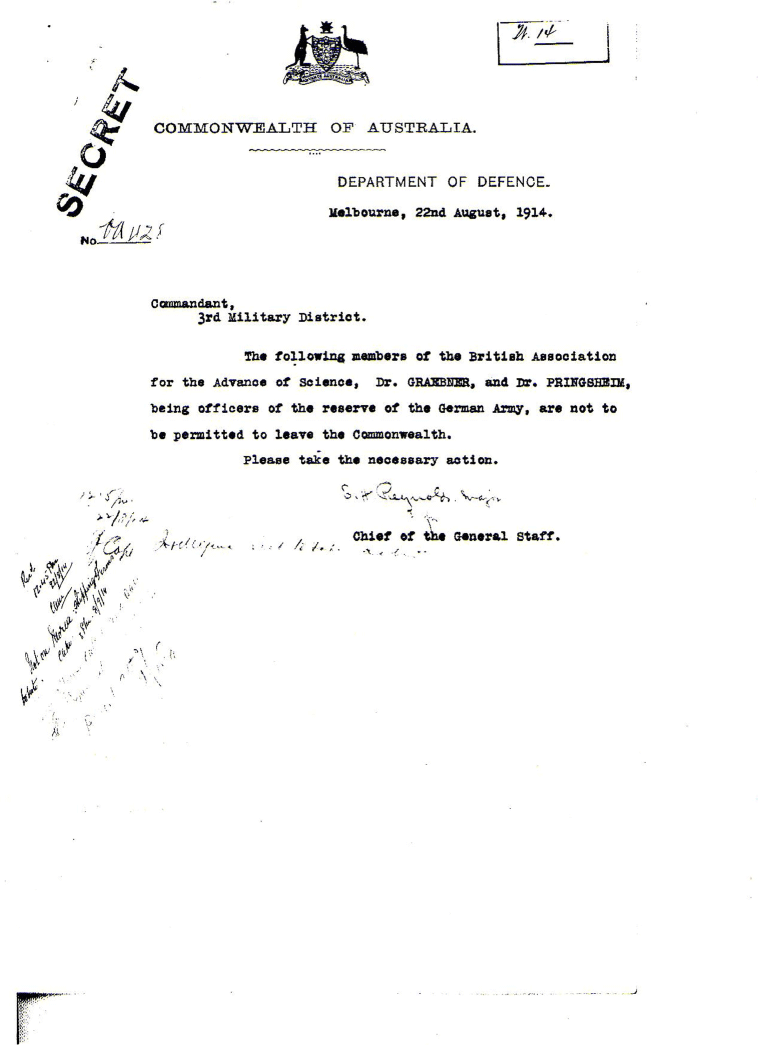
Peter Pringsheim’s signed declaration to the Australian military authorities that he would not take up arms against Great Britain or her allies or take part in any inimical activities. (MP 16/1, 14/3/124, National Archives of Australia, Canberra, ACT).
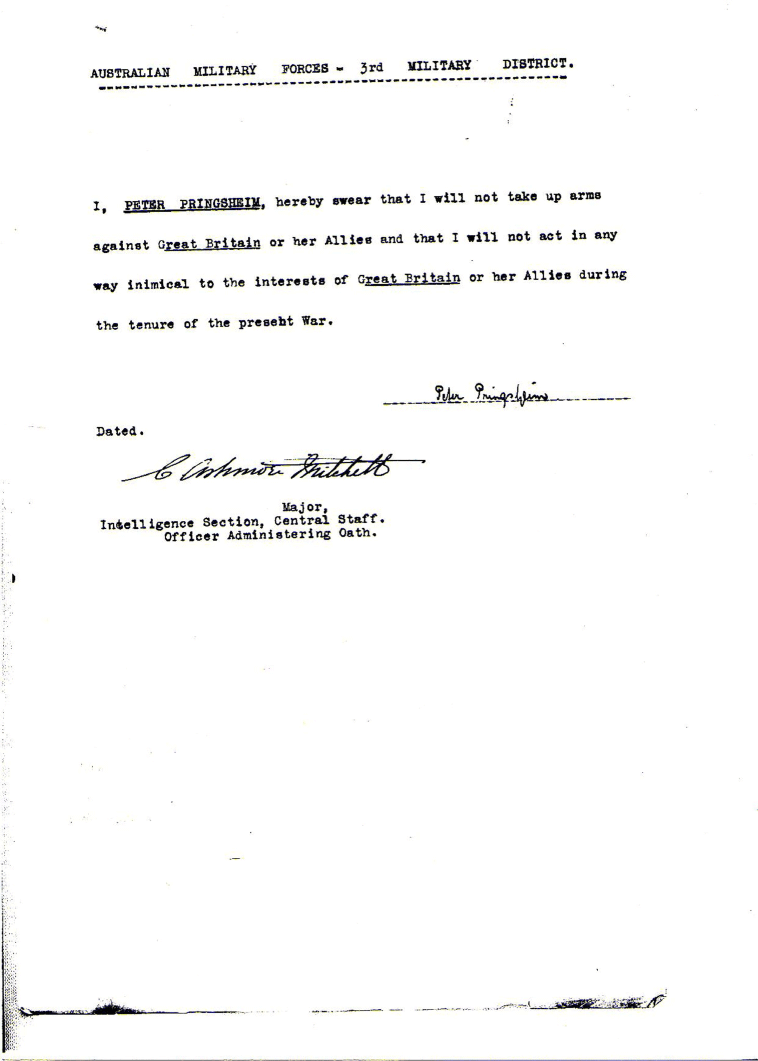
This memorandum of 7 November 1914 from Major Mitchell of the Intelligence Section of the 3rd Military District confirms that all letters to Pringsheim have been intercepted and nothing inappropriate has been found. (MP 16/1, 14/3/14, National Archives of Australia, Canberra, ACT).
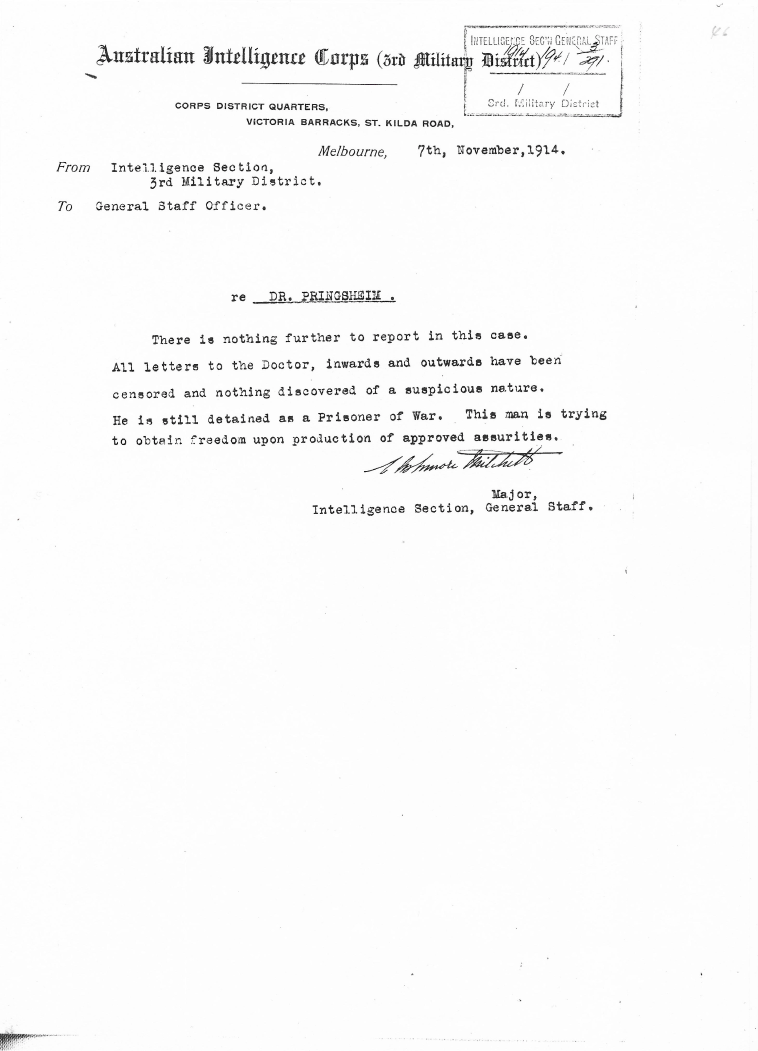
Despite this, Pringsheim was instructed to join Gräbner and some 500 other German and Austrian internees at the Trial Bay Internment Camp. Trial Bay was an internment camp for ‘enemy aliens’, that is, citizens of countries at war with the British Empire, who, in the opinion of the Australian authorities, needed to be interned for reasons of national security. Trial Bay was specifically set up to accommodate ‘first class’ internees, such as businessmen, ministers of religion, medical doctors, university lecturers and ships’ officers. In total, 6890 enemy aliens were interned during World War 1 in Australia. Trial Bay, with 500 internees, was a relatively small camp; the largest, Holsworthy, accommodated more than 5000. Trial Bay is on the east coast of Australia, approximately 500 km north of Sydney, overlooking the Tasman Sea. The camp in Trial Bay had been established in 1884 to house convicts, who were used to provide labour to construct a breakwater for a new harbour. However, attempts to build the breakwater were continually frustrated by the weather conditions, so that plans for a new harbour were finally shelved in 1903. The Trial Bay camp was converted into an internment camp in 1914.6 Trial Bay was not a concentration camp surrounded by barbed wire, however, as Pringsheim’s mother presumed,7 and Pringsheim was not a prisoner of war, as his brother-in-law Thomas Mann believed, judging from comments in his letter of 11 December 1914 to Philipp Witkop8 (Fig. 6). The internees had a relatively relaxed lifestyle; between 6 a.m. and 6 p.m. they had free access to the whole peninsula, where they could participate in sports activities and go swimming and fishing.9 The internees also attended regular lectures given by their fellow internees on philosophy, history, sociology, physics, metaphysics, arts and crafts, and took part in theatre and concert performances.10 In the 1920 Curriculum Vitae which Pringsheim included in his application for a professorship at the University of Berlin, he wrote that during his five years in internment he gave a large number of talks to his fellow internees on scientific subjects as well an entire lecture courses on topics such as ‘Foundations of Modern Atomic Physics’, ‘Radio Telegraphy’, ‘Theory of Sight’, and ‘Thermodynamics’ (Fig. 7).11
Envelope in Thomas Mann’s handwriting accompanying Mann’s letter to Peter Pringsheim of 6 November 1917, with censor’s handstamp. (Copy held in Thomas-Mann-Archiv der ETH, Zürich; many thanks to Dr Tobias Amslinger, Director of the Thomas-Mann-Archiv of the Swiss Federal Technical University, Zürich, email of 16 December 2023 and Dr. Sascha Michel, Lektorat Literatur, S. Fischer Verlag, Frankfurt a.M., email of 20 December 2023, for permission to reproduce this item).

Peter Pringsheim’s registration as ‘Enemy Alien’ at the Trial Bay Internment Camp, 1917. (SP 43/3 Alien Registration Forms 1916–1922, National Archives of Australia, Sydney).
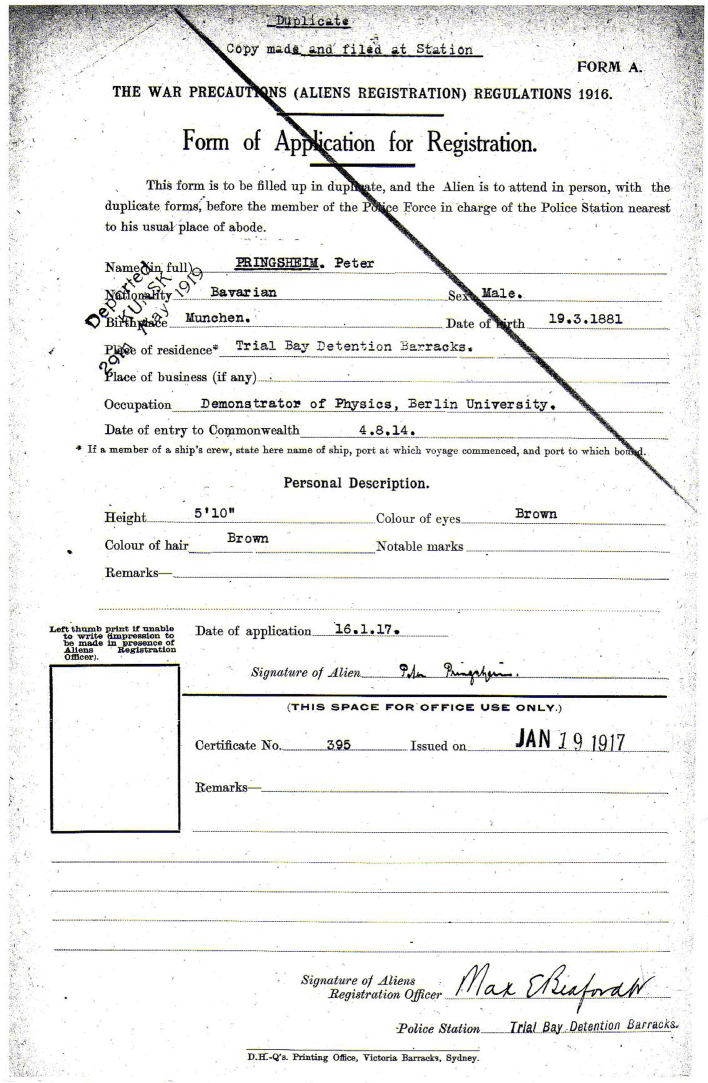
In the foreword to the book which Peter Pringsheim worked on while in Australia, Fluoreszenz und Phosphoreszenz im Lichte der neueren Atomtheorie (Fluorescence and Phosphorescence in the Light of the recent Atomic Theory), that was published in Berlin in 1921 by Springer-Verlag, Pringsheim acknowledges three Australian professors in particular for having enabled him to keep track of the latest developments in his area of scientific research by passing on to him the latest publications and journal articles as they appeared. He thanks for their kindness and generosity Professor Thomas Ranken Lyle, Professor of Natural Philosophy at the University of Melbourne, Professor James Arthur Pollock, Professor of Physics at the University of Sydney, and his former student colleague Dr Edward Montague Wellisch, who, appointed to the Department of Mathematics at the University of Sydney in 1915, became a highly regarded professor of mathematics.12 Another professor who came to Pringsheim’s aid was the New Zealander Ernest Rutherford,13 who was a professor of physics at the University of Manchester. Rutherford was one of the pioneers of the study of radioactivity, transforming the institutes he led in Montreal (1898–1907), Manchester (1907–1919) and Cambridge (from 1919) into centres of research into radioactive, atomic, and nuclear physics. He held Pringsheim in high regard, having attended the same conference of the British Association for the Advancement of Science that Pringsheim attended in 1914. Among other things Rutherford would undoubtedly have appreciated, as James Franck and Robert Pohl point out, that Pringsheim’s findings in his PhD thesis, supervised by Röntgen, had had a direct impact on Hans Geiger’s subsequent construction of the universally known Geiger Counter.14 Pringsheim wrote to Ernest Rutherford in 1915, seeking his assistance in his attempts to remain in contact with current research in his field.15
All letters to and from internees in Trial Bay were read by the ‘Postal Censor’, and if anything suspicious or inappropriate was found, the letter would be confiscated, translated, and shown to the Camp Commandant. Certain topics were not allowed to come up in letters, particularly any comments on the political or military situation, or any remarks that could be construed as hostile to the host country; any attempts to write in code or include a secret message were also strictly forbidden. Army Council Instruction No. 305 on correspondence reads in part: ‘Letters censored locally which (a) deal with the political situation or with naval and military operations; or (b) contain fact or fiction tending to encourage the enemy; or (c) show channels of hostile trade, communication, &c.; or (d) appear to conceal secret writing, &c., will be submitted to the Postal Censor.’16 Only short and clearly legible letters on personal or business matters were to be forwarded to the internees. The exact wording of the Instruction is as follows: ‘Letters may relate only to private affairs or to business matters in which the prisoner has a personal interest’.17 It may well be that, in Pringsheim’s case, letters and printed material relating to physics research were regarded as business correspondence; he was certainly allowed to receive material relating to his research. Thomas Lyle obtained permission in December 1914 to visit Pringsheim in the internment camp;18 he and James Pollock then brought him a regular supply of physics literature, although these books were subject to the normal inspection applied to all reading material by the camp censors. This, together with the help he received from Edward Wellisch and Ernest Rutherford, enabled Pringsheim to produce an outstanding piece of up-to-date research. After five years in internment, Pringsheim finally left Australia in July 1919, and returned to Berlin.19
On 4 June 1920, the Dean of the Faculty of Philosophy of the Friedrich Wilhelm University of Berlin forwarded the manuscript that Peter Pringsheim had written while in Australia together with a number of his shorter scientific works to Heinrich Rubens, professor of experimental physics, and Professor Max Planck, professor of theoretical physics, for their assessment in the light of Pringsheim’s application for professorial status. In his report of 13 June 1920, Professor Rubens concluded that all of Pringsheim’s works submitted ‘fully satisfy the strict requirements that we must set'. In his report of 24 June, Professor Planck, who had been awarded the Nobel Prize in Physics in 1919, wrote that he agreed with Professor Rubens’ comments. On 25 June 1920, these reports by Professor Rubens and Professor Planck were circulated to the seven members of the Professorial Promotions Committee (Habilitationsausschuss) of the Faculty of Philosophy asking whether, on the basis of the submitted works and the two reports, they supported the proposal that Pringsheim be granted promotion to professor.
The professors consulted were some of the most outstanding researchers in Germany at the time. Max von Laue, professor of technical physics, had received the 1914 Nobel Prize for Physics for his discovery and evaluation of X-ray interference; Walther Nernst, professor of physical chemistry, was awarded the 1920 Nobel Prize for Chemistry in recognition of his work in thermochemistry. The other professors consulted were also very prominent in their fields. Arthur Wehnelt, professor of physics, was best known for having invented the Wehnelt cylinder, used to focus the electron beam; Professor Ernst Beckmann, professor of chemistry, invented the Beckmann differential thermometer; Erhardt Schmidt, professor of mathematics, was identified with the development of functional analysis; Theodor Liebisch, professor of mineralogy, was associated most with ‘Liebisch twinning’, used in crystallography; and Gustav Hellmann, a prominent meteorologist, was professor of meteorology and head of the Prussian Meteorological Institute.20 On the form forwarded from the dean’s office to the Professorial Promotions Committee on 25 June 1920, each member of the committee wrote a comment together with a signature and date. Von Laue, Wehnelt, Beckmann, Liebisch and Hellmann all wrote ‘Für Zulassung’ (in favour of promotion to professor), with Liebisch and Hellmann adding the word ‘Ebenso!’ (I agree!), while Nernst and Schmidt simply wrote ‘Ebenso!’ In other words, the committee’s decision was unanimous, and emphatically so. The dean signed off the form at the faculty meeting of 9 July and the official certificate confirming his professorial status was presented to Pringsheim on 30 October 1920.21 Bearing in mind the standing and international reputation of the professors who had been asked to evaluate his work, it is nothing short of remarkable that Pringsheim’s research, having been produced under such difficult circumstances, should receive such unreserved academic endorsement (Fig. 8). Professor Lyle of the University of Melbourne and Professors Pollock and Wellisch of the University of Sydney, together with Professor Rutherford of the University of Manchester, who incidentally was also a Nobel Prize winner, having been awarded the 1908 Nobel Prize for Chemistry, could be justifiably proud of their contribution to Pringsheim’s success.22
The Dean of the Faculty of Philosophy of the Friedrich Wilhelm University of Berlin circulated this form on 25 June 1920 to the seven members of the Professorial Promotions Committee, Profs. von Laue, Wehnelt, Beckmann, Nernst, Schmidt, Liebisch and Hellmann, to accompany reports by Professor Rubens and Professor Planck on the scientific works that Peter Pringsheim had submitted to the Faculty for consideration for promotion to Professor. The manuscript that Pringsheim had written during his internment in Australia formed the major part of the works submitted. The Committee members were asked whether, on the basis of the submitted works and the two reports, they supported the proposal that Pringsheim be granted promotion to professor. All seven professors, including two Nobel Prize winners, Max von Laue and Walther Nernst, responded enthusiastically, and the recommendation for Pringsheim’s promotion was unanimous. When he published his Australian manuscript the following year, Pringsheim acknowledged in his foreword the help that he had gratefully received from Professors Lyle (University of Melbourne), Pollock, and Wellisch (University of Sydney) during his internment in Australia. (Universitätsarchiv, Humboldt-Universität zu Berlin, HU UA, Phil.Fak.01, Nr. 1273, 108. Scan reproduction: Humboldt University Archives, 27 September 2023; permission for publication granted by Humboldt University Archives Director, Dr Aleksandra Pawliczek, 21 November 2023).
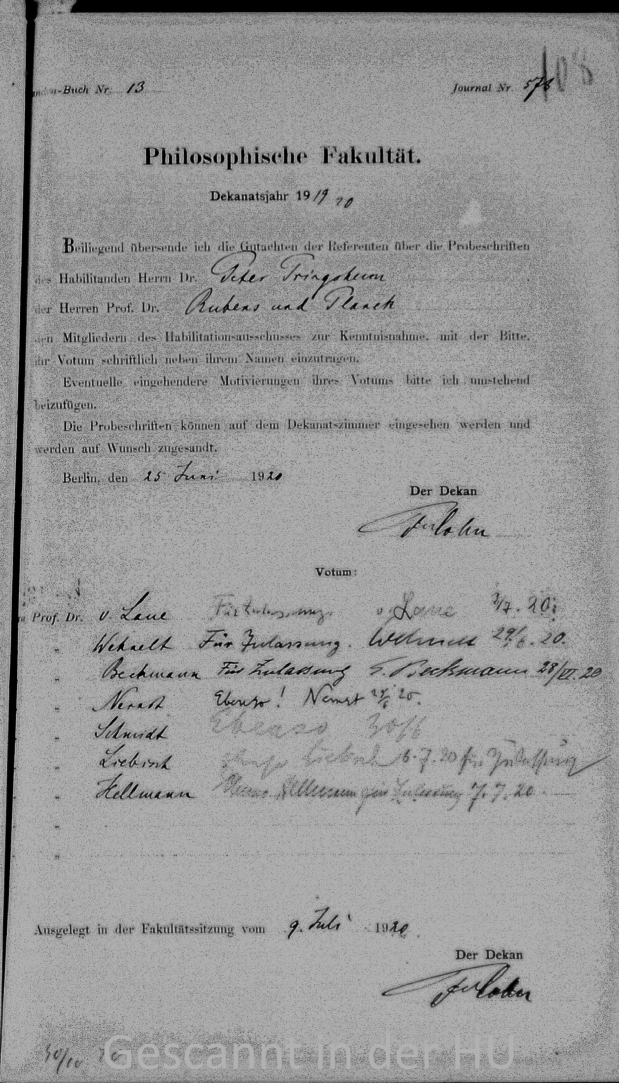
Pringsheim went on to publish his research findings the following year in Fluoreszenz und Phosphoreszenz im Lichte der neueren Atomtheorie, which proceeded to two revised editions in German in 1923 and 1928, and an American edition in 1949. In his 1923 foreword, written in Berlin during the 1922 Christmas break (Berlin, Weihnachten 1922), Pringsheim remarks on the remarkable number (ansehnliche Zahl) of scientific works on the topic that had been published in the eighteen months since the first edition appeared. His 1923 bibliography lists sixty new publications that appeared in 1921 and 1922, including four by Pringsheim himself.23 Ernst Lamla points to the marked increase in the length of Pringsheim’s bibliography in each edition as evidence of the rapidly growing interest in Pringsheim’s area of research. The 1921 edition lists 266 scientific works in the bibliography, the 1923 edition 327, the 1928 edition 637, and the 1949 edition 1936.24 The physicist Wilhelm Hanle refers to the American edition as a ‘Standardwerk’, compulsory reading for all scientists working in this area; the journal Nature characterises it as ‘a comprehensive review of luminescence in the gaseous, liquid and solid states’, a ‘monumental text’ and ‘a landmark in luminescence’; and in its various editions, Pringsheim’s book is defined in Physics Today as ‘one of the most comprehensive reference works on luminescence in the literature’.25 Writing in 1965, the British physical chemist Edmund Bowen described Pringsheim’s German edition as having been for many years ‘the only authoritative book on the subject’, while the American edition had been ‘of immense value’ to more recent workers in this subject—‘not only because of its completeness and reliability, but also because of the clear and critical exposition of the facts in a manner so characteristic of the author’.26
With such overwhelming support from his academic colleagues, nothing, it seemed, could now stand in his way. He was regarded at the time as a key member of a group of trail-blazing physicists in Berlin, who are listed by Horst Kant as Otto von Baeyer (1877–1946), James Franck (1882–1964), Gustav Hertz (1887–1975), Peter Pringsheim (1881–1964) and Wilhelm Westphal (1882–1978).27 Otto von Baeyer was appointed professor of physics at the Agricultural University of Berlin (Landwirtschaftliche Hochschule) in 1921; James Franck and Gustav Hertz were jointly awarded the Nobel Prize in Physics in 1925, and went on to take up professorial positions at the University of Chicago and the Technical University of Berlin respectively; Wilhelm Westphal became professor of physics at the Technical University of Berlin.28 In the 1920s, Peter Pringsheim’s career seemed to be following a similar pattern. He married his Belgian wife Emilia Clémont, originally from Borgerhaut, near Antwerp, in December 1923; in April 1925 he was appointed to a full-time professorship at the Friedrich Wilhelm University of Berlin, and in January 1930 his professorship became permanent.29 He was a respected fellow of the Berliner Physikalische Gesellschaft (Association of Berlin Physicists) and was its president from 1927 to 1931.30 The way was now clear, one would have assumed, for Pringsheim to pursue a brilliant academic career.
After the seizure of power by the Nazis in 1933, however, Pringsheim once again became a victim of circumstances over which he had no control. On 13 May the university was informed by the National Socialist authorities that, on the basis of the newly enacted legislation of 7 April 1933 on the reinstatement of professional civil servants, individuals regarded by the government as Jews were to be immediately granted leave until further notice.31 On 16 May, the rector of the university wrote to Pringsheim and two of his professorial colleagues stating that, on account of the new legislation, they were to be relieved of all of their university duties with immediate effect32 (Fig. 9). The newly enacted legislation to which the memoranda refer has the wording: ‘Beamte, die nicht arischer Abstammung sind, sind in den Ruhestand zu versetzen’, that is ‘Civil servants who are not of Aryan descent are to be retired’.33 On 5 September, a copy of a memorandum signed by State Secretary Wilhelm Stuckart ostensibly on behalf of the Prussian Minister of Science, Art and Education was forwarded to Pringsheim by the rector of the university, Eugen Fischer. The memorandum informed him succinctly that on the basis of paragraph 3 of the law of reinstatement of professional civil servants of 7 April 1933 he was herewith placed in retirement.34 Wilhelm Stuckart, a lawyer in the higher echelons of the Nazi movement who signed the memorandum, was later involved with the antisemitic Nuremberg laws of 1935.35
This is how Pringsheim was officially informed that he had lost his job at the University of Berlin due to his Jewish heritage. Ostensibly from the office of the Prussian Minister of Science, and in fact signed by the Nazi lawyer Wilhelm Stuckart (who was later involved with the antisemitic Nuremberg Laws), the memorandum reads that on the basis of paragraph 3 of the law of the reinstatement of the professional civil service of 7 April 1933, Pringsheim was hereby to be ‘placed in retirement’. (Memorandum of 5 September 1933 to Pringsheim, Universitätsarchiv, Humboldt-Universität zu Berlin, U I Nr. 8255, Berlin, HU UA, UK Personalia P 179, Pringsheim, 6. Photograph: Margaret Bade, archival visit 25 September 2023; permission for publication granted by Humboldt University Archives Director, Dr Aleksandra Pawliczek, 21 November 2023).
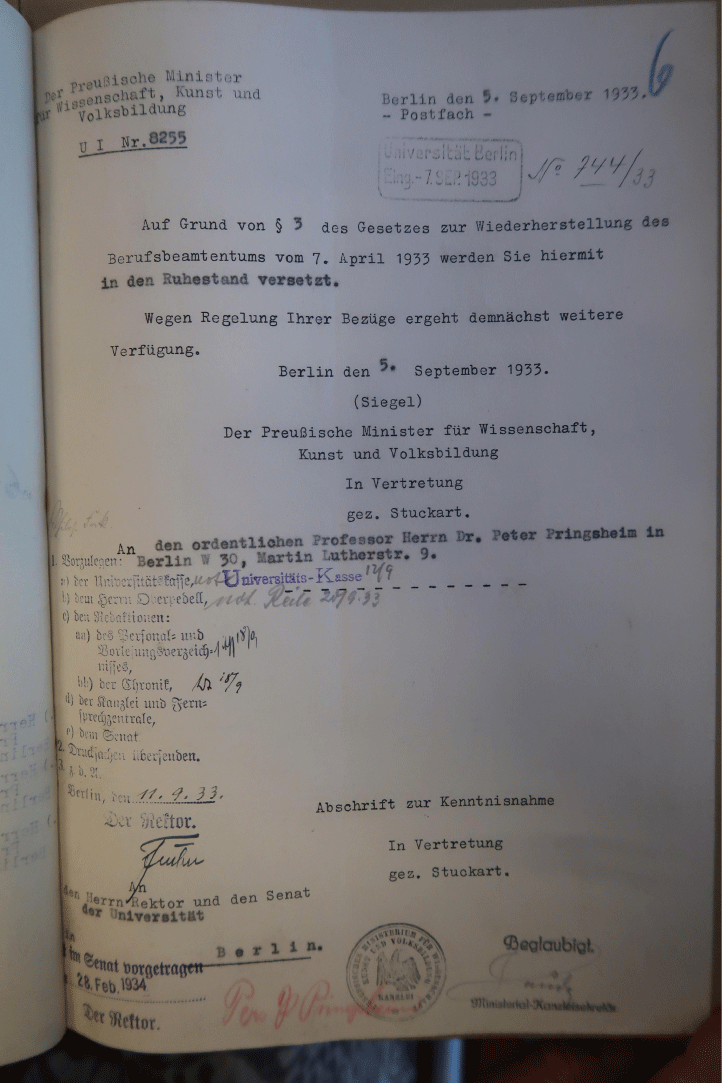
Doubtless with the assistance of his wife Emilie and her Belgian connections, Pringsheim subsequently managed to find a position at the Université Libre in Brussels under the Swiss professor of physics, Auguste Piccard, who had previously held the Chair of Mechanics at the Swiss Federal Institute of Technology (ETH) in Zürich. Pringsheim spent nearly seven years lecturing at the Faculté des Sciences Appliquées of the Université Libre, until he was arrested when German troops marched into Brussels on 10 May 1940; he was then sent to the Gurs concentration camp in southern France.36 At this point Pringsheim’s sister Katia Mann and her husband Thomas Mann, now both living in exile in the United States, stepped in to help. Thomas and Katia Mann worked with Pringsheim’s former colleague in Berlin, James Franck, now in Chicago, to create a ‘Research Associate’ position for Pringsheim at the University of California, Berkeley.37 With the resulting ‘non-quota immigrant visa’ for the United States, which was issued on 5 December 1940, Pringsheim was thus given permission the following day to leave Gurs and to travel to the United States.38 As all those held at the Gurs concentration camp who were not able to secure foreign assistance were sent to the gas chambers of the Nazi extermination camps in Eastern Europe, the intervention by Thomas Mann, highly esteemed at Berkeley, was a key component in Pringsheim’s survival.39 Peter Pringsheim owed his life to his sister Katia Mann, his brother-in-law Thomas Mann and the influential personalities in the United States whom Mann knew, along with the tireless efforts put in by James Franck, now a professor of physical chemistry at the University of Chicago,40 to gain him an academic position at an American university. Interestingly, Thomas Mann was also a Nobel Prizewinner, having been awarded the Nobel Prize in Literature in 1929, bringing the total of Nobel Prizewinners who supported Pringsheim at key times in his life to eight—Wilhelm Röntgen, J. J. Thomson, Ernest Rutherford, Max Planck, Max von Laue, Walther Nernst, James Franck and Thomas Mann.
Peter Pringsheim was thus able to join the ‘colony of German refugees’ in California, as Katia Mann, Pringsheim’s sister, put it.41 One of the highlights of Pringsheim’s time at Berkeley was being able to join his sister Katia and his brother-in-law Thomas Mann for the bestowal of Mann’s honorary doctorate at Berkeley on 27 March 194142 (Fig. 10). The following year Pringsheim took up a Samuel Fels Foundation laboratory position under James Franck at the University of Chicago,43 after which he was from 1944 to 1946 director of research at the Ray Control Company in Pasadena, California. From 1947 to 1954 he worked at the Argonne National Laboratory in Chicago, at that time under the University of Chicago.44 In 1954, he returned with his wife to Belgium; they decided to make Antwerp their home. He died on 20 November 1963 in Antwerp.45
One of the highlights for Peter Pringsheim of his time at Berkeley was the opportunity to join his sister Katia and brother-in-law Thomas Mann at the ceremony bestowing an honorary doctorate on Mann at the University of California, Berkeley on 27 March 1941. Here we see Pringsheim (right) shaking hands with Thomas Mann, with Katia good-humouredly looking on. (ETH-Bibliothek Zürich, Thomas-Mann-Archiv/Photographer unknown/TMA_3003. Many thanks to Rolf Bolt of the Thomas-Mann-Archiv of the Swiss Federal Technical University, Zürich for locating the photograph and supplying the correct archival data, 9–10 January 2024, and to the Director of the Thomas-Mann-Archiv, Dr Tobias Amslinger, email of 11 January 2024, for permission to publish the photograph).
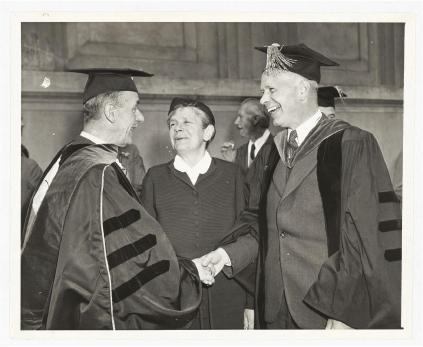
It is a tragic irony that Pringsheim was held captive twice in his life: first as a German and ‘enemy alien’ in Australia; then as a Jew, and therefore according to the Nuremberg race laws ‘not of German blood’, in Nazi-occupied Belgium. And yet he apparently harboured no resentment towards his Australian and German colleagues. In a preface to his key 1921 work on fluorescence and phosphorescence, he thanked his Australian colleagues for their help, and the German nuclear physicist Wilhelm Hanle noted in his 1961 tribute to Pringsheim that despite his having suffered considerable injustice from the German authorities during the Nazi dictatorship, Pringsheim showed no ill will towards his German colleagues after the war and always approached them with the same innate friendliness. This was particularly apparent on the occasion of his eightieth birthday in 1961, when Pringsheim received an honorary Doctorate of Science from the University of Gießen in Germany, which, Hanle writes, was an unforgettable experience for all who took part.46 Perhaps the most moving tribute to Pringsheim was that sent to Emilia Pringsheim by Nobel Prizewinner Professor James Franck when he learned of Pringsheim’s death. He described Pringsheim as a fine and unique person, intellectually gifted and exceptionally knowledgeable. ‘What particularly appealed to me about him was his loyalty to others, and his incredible honesty as far as he himself was concerned. He shied away from boasting about his achievements; if anything, he tended to underestimate himself.’ Franck emphasised Pringsheim’s eagerness to help others; he wrote that Pringsheim always put others’ interests before his own. ‘In summary, Peter Pringsheim was the sort of person one rarely has the privilege to meet in this life.’47
Data availability
The data used to generate the results in this paper are available at the following archives: Humboldt University Archives, Berlin; Thomas Mann Archive of the Swiss Federal Institute of Technology, Zürich; National Archives of Australia, Sydney and Canberra; Australian War Memorial, Canberra.
References
Anonymous (1961) Prof. Peter Pringsheim, Nature, 189, 877.
| Google Scholar |
Anonymous (1964) Peter Pringsheim, Physics Today, 17(3), 90-91.
| Google Scholar |
Bowen, E. J. (1965) Dr Peter Pringsheim, Nature, 205, 1158.
| Google Scholar |
Fischer, G. (1983) Beethoven’s Fifth in Trial Bay: culture and everyday life in an Australian internment camp during World War I, Journal of the Royal Australian Historical Society, 69(1), 48-62.
| Google Scholar |
Franck, J., and Pohl, R. W. (1964) Persönliches: Peter Pringsheim, Physikalische Blätter, 20(3), 133-134.
| Google Scholar |
Gearhart, C. A. (2014) The Franck-Hertz experiments: 1911–1914 experimentalists in search of a theory, Physics in Perspective, 16(3), 293-343.
| Google Scholar |
Hanle, W. (1964) Zum Gedenken an Peter Pringsheim, Die Naturwissenschaften, 51(7), 153-154.
| Google Scholar |
Hardy, A. (2013) ‘James Franck und Thomas Mann verhalfen ihm zur Flucht. 20.11.2013—Vor fünfzig Jahren starb Peter Pringsheim’, https://www.pro-physik.de/nachrichten/james-franck-und-thomas-mann-verhalfen-ihm-zur-flucht, viewed September 2023.
Hettner, G., and Hahn, O. (1947) Zur Erinnerung an Otto v. Baeyer, Die Naturwissenschaften, 34(7), 193-4.
| Google Scholar |
Kant, H. (2005) ‘Forschungen über Radioaktivität am Kaiser-Wilhelm-Institut für Chemie: Die Abteilung(en) Hahn/Meitner und ihre internationalen Kontakte’, in Aus Wissenschaftsgeschichte und -theorie: Hubert Laitko zum 70. Geburtstag, eds H. Kant and A. Vogt, Verlag für Wissenschafts- und Regionalgeschichte, Berlin, pp. 289–320.
Lamla, E. (1961) Peter Pringsheim zum achtzigsten Geburtstag, Die Naturwissenschaften, 48(6), 11.
| Google Scholar |
Turner, I. S. (1952) The First Hundred Years of Mathematics, Teachers’ College, Sydney, https://www.maths.usyd.edu.au/u/About/1st_hundred_years.pdf, viewed November 2023.
Twigg, C. (n.d.) ‘Rutherford’s secret war’, https://www.ww1.manchester.ac.uk/rutherfords-secret-war/, viewed November 2023.
Wolff, S. L. (2003) ‘Physicists on the “Krieg der Geister”’: Wilhelm Wien’s “Proclamation”, Historical Studies in the Physical and Biological Sciences, 33(2), 337-368.
| Google Scholar |
Footnotes
1 Mann (1975) p. 44. Jens and Jens (2003) p. 26. Hermann Ebers quoted in Krause (2006) p. 18. Reich-Ranicki (1989) pp. 191–193. Wehefritz (1999) pp. 11–14, 22–3. I would like at this point to thank Annekatrin Gehnen and Sarah Müller of TU Dortmund University Library for making Wehefritz’s study available.
2 Pringsheim (1920) ‘Lebenslauf’ pp. 1–2. Pringsheim (1925) ‘Personalnachrichten’. The Conference was held in Melbourne, but participants also visited Adelaide, Sydney, and Brisbane. See ‘Society’ column, Punch (Melbourne) 23 July 1914, p. 8. According to a report in the Sydney Morning Herald of 23 July 1914, seven German scientists attended the conference: four from Berlin – Pringsheim, along with Profs. von Luschan, Penck, and Goldstein; and Gräbner, along with Profs. Walther and Maas, from Cologne, Halle, and Munich respectively. I would like at this point to thank the staff of the Humboldt University Archives, Berlin, particularly Kevin Aegerter and Sabrina Rübisch, for assisting my wife Margaret and myself in our invaluable research visits to the Archives on 25 and 27 September 2023, and the Humboldt University Archives Director, Dr Aleksandra Pawliczek, for granting permission on 21 November 2023 to reproduce documents from the Archives.
3 Fischer (1983) p. 49. Wehefritz (1999) p. 23.
4 Wallack (1914). The following note is written at the conclusion of the letter: ‘Cancel permission to leave and this man should be kept under observation also Dr. Pringsheim.’ A Sydney Morning Herald report of 1 September 1914 entitled ‘Montoro’s Passengers’ mistakenly lists ‘Dr Peter Pringsheim’ and ‘Dr F. Graebner’ as leaving that day for Singapore. This indicates that at that early stage the Australian authorities were happy for Gräbner and Pringsheim to return to Germany. A Melbourne Age report of 5 January 1915 entitled ‘Australia and the German Menace’ quotes Professor David Orme Masson, Secretary of the British Association, as saying that both Gräbner and Pringsheim were ‘made to suffer’ because of Gräbner’s correspondence.
5 Memorandum, 7 November 1914, Major Mitchell, Australian Intelligence Corps (3rd Military District), Melbourne, to General Staff Officer, MP 16/1, 14/3/14, National Archives of Australia, Canberra, ACT.
6 Fischer (1983) p. 48. Wehefritz (1999), p. 23.
7 In a letter to Frau Björnson dated 3 December 1915, in Wiedemann (1985) p. 24, Hedwig Pringsheim-Dohm describes her son Peter Pringsheim as being cut off from the world by barbed wire as a prisoner of war in an Australian concentration camp: ‘in australischem Concentrationslager kriegsgefangen und durch Stacheldraht von der Welt abgeschnitten.’
8 The envelope containing Thomas Mann’s letter to Peter Pringsheim of 6 November 1917 (Thomas-Mann-Archiv Zürich) is headed ‘Kriegsgefangenensendung’ (Prisoner of War Mail). Mann wrote to Philipp Witkop of his brother-in-law who was a ‘Kriegsgefangener’ (Prisoner of War) in Australia: ‘der hat es am schwersten‘ (he is worst off). See Mann (2004) p. 45. According to Harpprecht (1995) p. 390, the Manns’ children prayed every night for their uncle Peter Pringsheim, who, after a completely unexpected turn of events, had now been summarily interned in far-off Australia: ‘den die Ereignisse im fernen Australien überrascht hatten, wo er unverzüglich interniert worden war’.
9 Fischer (1983) p. 51.
10 Trojan (1922) pp. 88–89.
11 Pringsheim (1920) ‘Lebenslauf’ p. 2.
12 ‘Wellisch, Edward Montague’, in: Encyclopaedia of Australian Science and Innovation, https://www.eoas.info/biogs/P000882b.htm, viewed November 2023. Wellisch was also known from 1920 onwards as Wellish. Turner (1952) p. 11: ‘Professor Wellish made a contribution to the work of the Department unique in its history for selfless devotion to duty.’
14 Kant (2005) pp. 291–292. Twigg (n.d.). Franck and Pohl (1964) pp. 133–134.
15 Wolff (2003) p. 339. Cambridge University Library assistant Johanna Ward (email of 5 October 2023) has kindly confirmed that an unpublished letter from Peter Pringsheim to Ernest Rutherford dated 15 November 1915 is held in the Rutherford Papers at the Cambridge University Library. Rutherford later went on to help found the Academic Assistance Council, which supported scientists targeted by Nazi and fascist regimes, aiming in particular to provide relief for intellectuals and teachers of Jewish heritage rendered refugees by Hitler’s race-based purges. Professor Mark Oliphant of the University of Birmingham recalled that Rutherford was shocked to find that ‘the greatest of the German scientists, some of whom had worked with him and many of whom he knew intimately, were among the victims.’ See Ramsey (2019) p. 173.
16 Army Council Instruction No. 305 of 1917, Instructions relative to the Internment and Treatment of Enemy Subjects, Correspondence of Prisoners of War, National Archives of Australia, Canberra, No X, §31(i), p. 8, A 11803, 1917/89/574.
17 Army Council Instruction No. 305 of 1917, Instructions relative to the Internment and Treatment of Enemy Subjects, Correspondence of Prisoners of War, National Archives of Australia, Canberra, No X, §4 and §19, A 11803, 1917/89/574.
18 Memorandum, 29 December 1914, from the Intelligence Section, Commonwealth Military Forces, 3rd Military District, Melbourne, to the General Staff Officer, MP 16/1, 14/3/424, National Archives, Canberra, ACT.
19 Wehefritz (1999) p. 24.
20 For further information see Peschke (2010) pp. 180, 196–197, 213, 235.
21 Pringsheim (1920). HU UA, Phil.Fak.01, Nr. 1273, esp. pp. 102, 103, 108, 110.
22 See Franck and Pohl (1964) p. 134: ‘Seine guten Bekannten in Australien und vermutlich Rutherford, der ihn schätzte, sorgten dafür, daß ihm Zeitschriften und Bücher aus einer dem Lager benachbarten Universität zur Verfügung standen. So kam er nach langer Isolation zurück, völlig versiert über die inzwischen gemachten Fortschritte in der Physik und mit einem fertiggeschriebenen Manuskript seines ersten Buches über Fluoreszenz.’ (His good friends in Australia and presumably Rutherford, who had a high opinion of him, made sure that he had access to journals and books from a university near the camp. In this way he returned from his long isolation completely informed on the advances made in physics in the meantime and with a completed manuscript of his first book on fluorescence.) For Rutherford, see also Cropper (2004) p. 317.
23 Pringsheim (1923) pp. VI, 221–224, 208–221.
24 See Lamla (1961) p. 11.
25 Hanle (1964) pp. 153–154. ‘Prof. Peter Pringsheim’ in Anonymous (1961) p. 877. Anonymous (1964) pp. 90–1.
26 Bowen (1965) p. 1158.
27 Kant (2005) pp. 291–292.
28 Hettner and Hahn (1947) pp. 193–194. Gearhart (2014) p. 293. Westphal (1968) p. iii. Wehefritz (1999) p. 34.
29 Pringsheim (1925) ‘Personalnachrichten’, 2 a–c, 7 a–b; Memoranda from Prussian Minister of Science, Art and Education to University Rector and Senate, Berlin, 31 January 1925 and 28 January 1930, in: Acta der Friedrich Wihelms-Universität zu Berlin betreffend o. Prof. Pringsheim, HU UA, UK Personalia P 179 1, 3, Universitätsarchiv Humboldt-Universität zu Berlin, accessed at archive 25 September 2023.
30 Anonymous (1964) pp. 90–91.
31 Memorandum, 13 May 1933, Prussian Minister of Science, Art and Education to University Rector and Senate, Berlin, HU UA, UK Personalia P 179, Universitätsarchiv, Humboldt-Universität zu Berlin; University Archives, Humboldt University of Berlin. The same file contains a ‘Personal Particulars’ form which lists Pringsheim’s religion as ‘protestant’. This reinforces the fact that the 1933 antisemitic legislation was aimed at those of Jewish ancestry rather than those whose religious affiliation was Jewish.
32 Memorandum, 16 May 1933, University Rector to three professorial staff members, Tgb. No. 395/396/33, Berlin, HU UA, UK Personalia P 179, Universitätsarchiv, Humboldt-Universität zu Berlin; University Archives, Humboldt University of Berlin.
33 Wehefritz (1999) p. 31.
34 Memorandum, 5 September 1933, Prussian Minister of Science, Art and Education, signed on his behalf by Secretary of State Wilhelm Stuckart, to Pringsheim, forwarded by University Rector Eugen Fischer to university offices on 11 September 1933 and presented to the University Senate on 28 February 1934, U I Nr. 8255, Berlin, HU UA, UK Personalia P 179, Universitätsarchiv, Humboldt Universität zu Berlin; University Archives, Humboldt University of Berlin.
35 See Jasch (2013) pp. 47ff.
36 Wehefritz (1999) pp. 31–34. See also Jens and Jens (2003) p. 218, and Mann (1996) p. 491.
37 See Bade (2010) p. 228.
38 Dannemann (2018) p. 181.
39 Wehefritz (1999) pp. 33–34. For Thomas Mann’s connection with the University of California, Berkeley, see Boes (2019) p. 89, and Corngold (2022) p. 153. Thomas Mann initially had a two-year Lectureship in Humanities at the University of Princeton from 1938 to 1940, after which he and his wife Katia moved to California, and had a house built at Pacific Palisades; see Mann (1997) pp. 9ff., and Mann (1975) pp. 109 ff. and 119 ff. Thomas Mann’s honorary doctorate from the University of California, Berkeley coincided with Pringsheim’s tenure at UC Berkeley. See Vaget (2011) p. 256, and Prater (1995) p. 322.
40 Lemmerich (2011) p. 224.
41 Mann (1975) p. 122. Pringsheim’s wife Emilia stayed back in Brussels and spent the rest of the war in Belgium. See Wehefritz (1999) p. 35.
42 Wysling and Schmidlin (1994) p. 369. Wehefritz (1999) pp. 36–37.
43 Lemmerich (2011) p. 238.
44 Wehefritz (1999) pp. 36–40. Prater (1995) p. 441. Wysling and Schmidlin (1994) p. 369.
45 Wehefritz (1999) pp. 41f. Jens and Jens (2003) pp. 273, 286.
46 Hanle (1964) p. 154.
47 Letter from James Franck to Emilia Pringsheim dated 5 December 1963, held at University of Chicago Library; quoted in Wehefritz (1999) p. 42. My translation.


